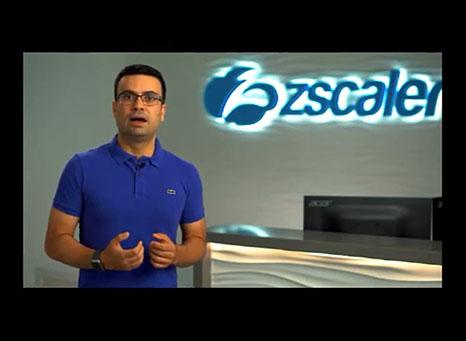/ What Is Endpoint Security?
What Is Endpoint Security?

Why Is Endpoint Security Important Today?
Today, most people are connecting to apps off the corporate network, outside of firewalls and network-based mobile devices, which can make threat detection and remediation more difficult for data protection strategies. This is especially true for the many companies that still depend on traditional network security solutions.
To this end, many users are now using personally owned devices and connecting over unsecured home networks. What’s more, devices run a range of nonstandard IoT operating systems in addition to the many flavors of Microsoft Windows, Google Android, macOS, and others.
Cybercriminals and hackers, seeing this trend, are using more sophisticated techniques and taking more targeted approaches in their attacks and malware campaigns—all with the goal of stealing sensitive data. As such, endpoint security software has had to evolve rapidly to keep up with the threat environment, bring your own device (BYOD) culture, and the rise in remote work.
Why the Cloud Is Crucial
Cloud-delivered endpoint security solutions make it easy for organizations to manage remote assets and endpoint devices. With the increase in remote work, endpoints have more entry points than ever. According to IDC, even with the growth in attacks against applications and cloud workloads, and despite increased IT spending on this threat surface, 70% of all breaches still originate at endpoints.
More employees working from home means more remotely connected devices, putting pressure on IT security admins to quickly adopt and configure cloud-based endpoint solutions that protect against advanced threats and data breaches. With these changes come specific cybersecurity risks:
- Misconfigurations
- Increased exposure to ransomware and other threats
- Unmanaged device sprawl
As security teams investigate more effective ways to protect their organizations’ data, networks, and end users without hindering productivity, they inevitably turn to cloud security, including cloud-delivered endpoint protection. Traditional antivirus solutions and enterprise network security won’t be able to stand up to today’s new threats, including fileless malware.
How Cloud-Based Endpoint Security Works
Typically, endpoint security solutions function in one of two categories: prevention (before an attack) and response (after a cyberattack). Modern endpoint protection platforms (EPPs) such as endpoint detection and response incorporate both categories managed via a single, centralized interface.
Endpoint security solutions deployed from the cloud bring security policies to users and provide threat protection and visibility that are always up to date. Where point products of the past could only provide fragmented protection and visibility over an organization’s remote endpoints, a cloud service allows for a more holistic view at the environment surrounding an endpoint, which makes it easier for security to diagnose a potential security issue.
Using a management console through on-premises endpoint security solutions creates vulnerability. With such a technique, there are distinct gaps in visibility and, moreover, lapses in security coverage that leave you open to threats designed to exploit them. A cloud native architecture, on the other hand, provides a much quicker setup and implementation as well as more holistic protection against the new era of threats. And, like a SaaS solution, cloud endpoint protection lets you scale services according to your environment’s needs at any given time.
Types of Endpoint Protection
Endpoint security solutions fall into a few main categories based on specific capabilities and reach:
- Endpoint detection and response (EDR) tools search for and oust threats at the endpoint. As with all endpoint protection tools, security professionals map threat hunting capabilities to identify, investigate, and remediate threats before they can infiltrate an endpoint and cause damage.
- Extended detection and response (XDR) solutions go beyond typical EDR to unify protection across a larger list of security tools. Effectively, XDR provides threat protection wherever data travels—inbound or outbound—hence “extended.”
- Managed detection and response (MDR) products provide the same security functions as EDR or XDR, but an organization using MDR will also benefit from management by a security operations center (SOC), giving the organization a team of threat hunters in its corner.
Endpoint Security Components
The key components of endpoint security all focus on protection and control of the underlying network (if there is one), data, applications, and so on. The main characteristics of typical endpoint security software are:
- Device protection
- Network control
- Application control
- Data loss prevention
- Browser protection
- Encryption
Through these components and more, organizations can secure their endpoints and the data traveling through them by proactively searching for threats wherever they can.
What Is the Difference Between Endpoint Security and a Firewall?
Endpoint security tools typically monitor potential threat activity at the endpoint, whereas firewalls inspect web-based traffic that attempts to enter a network. Fundamentally, the question isn’t so much “endpoint security vs. firewall” but “endpoint security vs. network security.”
To reiterate, network controls are fundamental to securing endpoints, especially in a remote setting, but in instances where endpoints are connecting directly to applications by forgoing the corporate network, there really isn’t much use for a firewall. In these instances, data and application controls are much more vital to an endpoint’s security.
Firewalls were essential to endpoint security when employees went to the office and needed corporate network security to inspect traffic as they worked. Today, endpoints are everywhere and endpoints aren’t used the way they used to be—endpoint security methodologies have left the firewall behind.
What Does Gartner Have to Say?
Gartner’s 2021 Planning Guide for Security and Risk Management advises, “cloud-based services and work-from-home scenarios...often make previously firewalled users and assets more exposed. Common attacks include siegeware and ransomware, business email compromise, and credential phishing and stuffing.”
This highlights perfectly why it’s a smart move to migrate to a cloud-delivered endpoint protection platform that gives your SecOps team complete visibility over possible threats and complete control over the security posture of your organization’s endpoints.
While many security vendors claim to have a “cloud-ready” product, only Zscaler gives your organization the power to protect endpoints via the cloud without interrupting or hampering digital experiences for end users.
Zscaler Endpoint Protection
Zscaler partners with leaders in endpoint security to control connectivity to corporate assets, isolate infected devices, and receive and share threat intelligence to deliver endpoint reporting to enterprise customers.
Zscaler enables organizations to boost endpoint-to-cloud security by reducing vulnerabilities and minimizing the impact of attacks. We do so by:
- Implementing zero trust access based on the real-time security posture of the endpoint
- Providing broad visibility into any compromised device connecting through the Zscaler cloud
- Updating protection continuously with more than 200,000 unique security updates per day in the Zscaler cloud
- Enabling immediate incident response with AI/ML-powered threat detection
- Delivering security as a service with unlimited scale
But how does our platform do it all? Here’s how:
- Cloud native EDR/EPP deploys endpoint sensors to devices alongside Zscaler Client Connector in a matter of hours
- Endpoint sensors send event-related data to the cloud for adaptive machine learning-based behavior and posture analysis
- Indicator of compromise (IoC) enrichment data feeds into the Zscaler Zero Trust Exchange™ so that single event data helps protect all users
Zero Trust with Endpoint Security
Zscaler integrates with industry-leading endpoint solution partners to provide zero trust access control based on device posture as well as enhance detection, investigation, and response capabilities—no matter where users and apps are—through telemetry and intelligence sharing.
We support compatibility between Zscaler Client Connector and various mobility management agents for devices.
The Zscaler technology partner ecosystem includes industry leading endpoint protection providers such as VMware Carbon Black, CrowdStrike, and SentinelOne.
Suggested Resources
FAQ
Frequently Asked Questions
Focus on verifying users and devices continuously, enforcing least-privileged access, and separating access with clear controls. Use tools like MFA and endpoint protection (e.g., EDR/XDR) to manage risks. Ensure visibility, keep systems updated with patches, and plan for monitoring and incident response. Compatibility with existing tools and clear remote-work policies are also key.
They key difference is that endpoint security protects individual devices, while network security focuses on the broader infrastructure and communication channels that connect those devices. Both work together to ensure comprehensive protection.
Endpoint security addresses a range of threats that target individual devices such as laptops, desktops, smartphones, IoT devices, and servers. Common Threats Addressed by Endpoint Security:
- Malware
- Ransomware
- Phishing Attacks
- Zero-Day Exploits
- Insider Threats
- Credential Theft
- Unsecured Devices
- Fileless Attacks
AI and machine learning (ML) are revolutionizing endpoint security by improving threat detection, response, and prevention. These technologies enhance traditional endpoint security tools, making them more effective at identifying and mitigating sophisticated attacks. Some examples include:
- Behavior-Based Threat Detection: ML models analyze user and device behavior to detect anomalies, such as unusual logins or file executions, that may signal malicious activity.
- Predictive Analytics: AI identifies patterns and predicts potential threats before they occur, reducing response time and improving prevention capabilities.
- Enhanced Malware Detection: ML algorithms identify previously unknown malware strains by analyzing code characteristics, bypassing reliance on static signatures.


